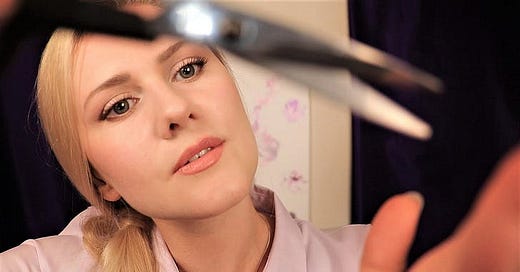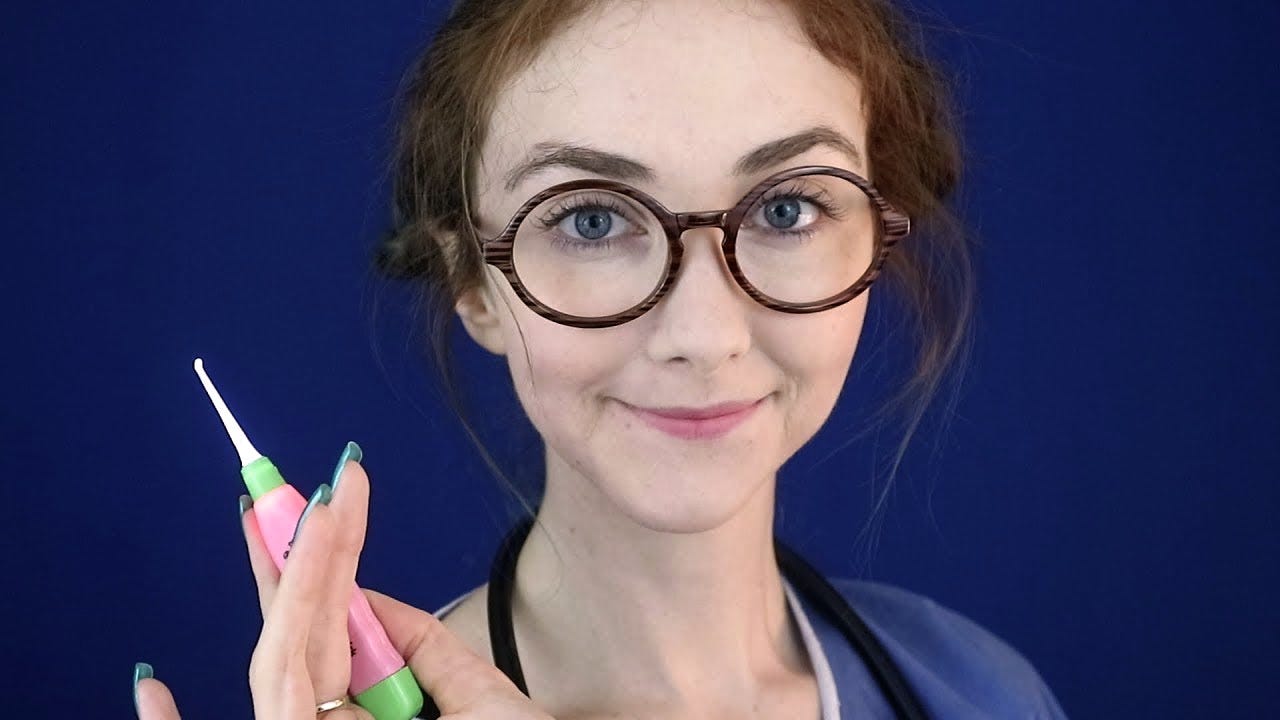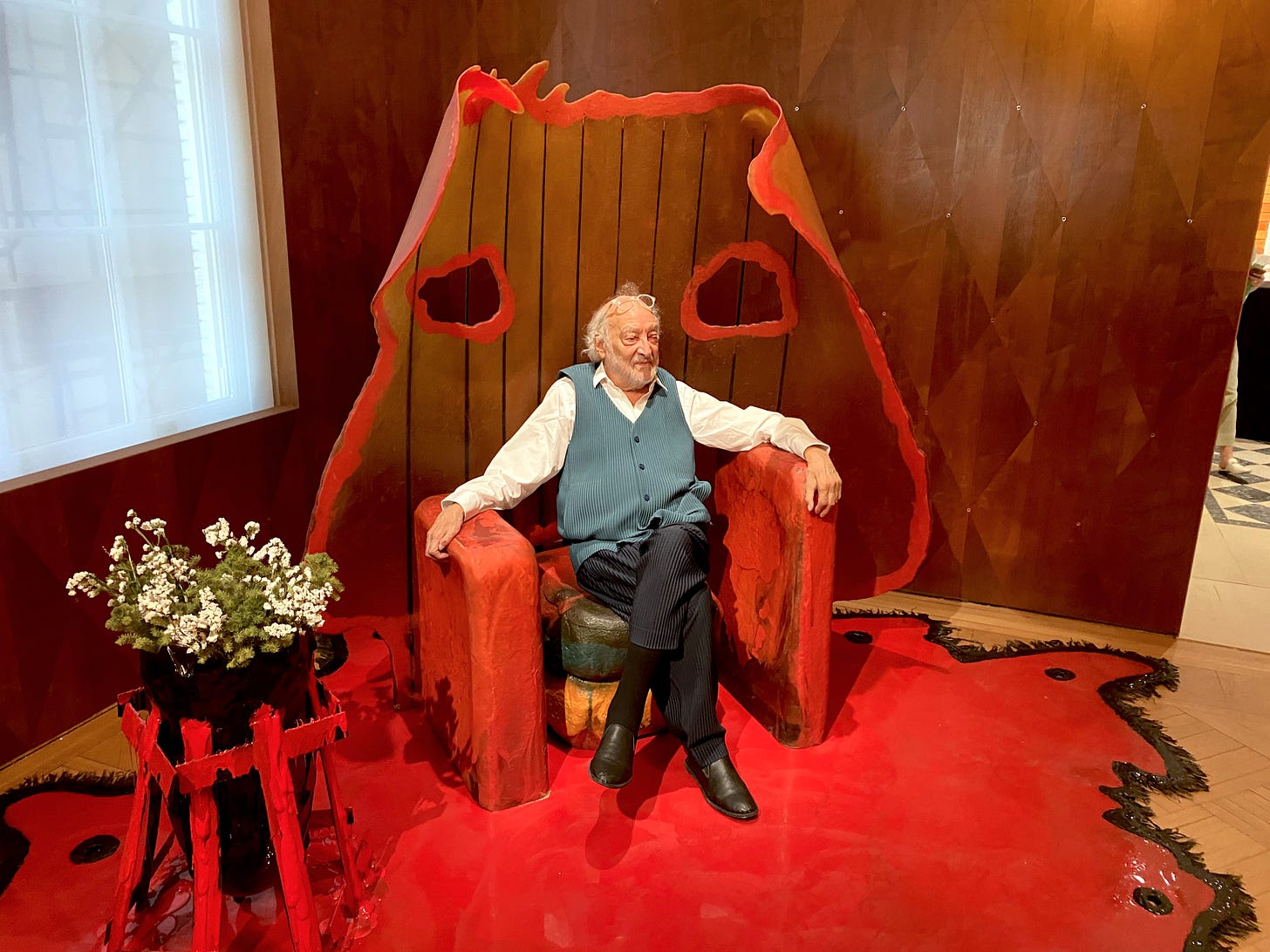Maybe Baby is a free Sunday newsletter. If you love it, consider supporting it financially. For $5/mo, you’ll gain access to my weekly recommendations, my monthly Q&A column, & my weekly podcast. Maybe Baby is reader-supported, hence the lack of ads and sponsors. Thank you!
Good morning!
You ever just Cozy Fall Coffee Shop Ambience: Relaxing Jazz Music & Rain Sounds for Studying, Relaxation, & Sleep?
In 2011, I came across a Reddit post asking if other people feel “weird” when they hear certain sounds. The post was accompanied by a compilation video of strange vignettes, like an air mattress being pushed down a narrow flight of stairs, the plastic making a slow, echo-y whine against the wall. “Does this make anyone feel something?” the poster asked. I knew what they meant right away, although I didn’t know why. I scrolled through the comments curiously. Half were mystified affirmations, the rest mystified denials. Nestled between them was an answer: “You might be experiencing ASMR.” I clicked through to a bare-bones, academic-looking website. ASMR stood for “Autonomous Sensory Meridian Response,” it said, and described a pleasurable tingling through the head and neck in response to certain auditory and visual triggers. “More research was needed.”
A series of experiences flashed through my mind: my childhood best friend’s mom knitting quietly on the couch, my classmate cutting careful triangles out of construction paper, the sound of my college roommate studying on a rainy day. That I might be experiencing a form of synesthesia in those moments never occurred to me. I simply assumed that people like Karen, my friend Sophia, and my roommate Kelsey maintained a special ability to calm me down. The only time I ever thought to put any of it to words was as a child, when I privately nicknamed these people “delicates.” In 2009, when I became enamored with a YouTube video that mimicked the experience of getting a haircut, I never thought to connect the two.
One year later, ASMR was recognized and named. And a year after that, the Reddit thread led me to YouTube, where a handful of creators were making videos to purposely incite this pleasure response, nicknamed “tingles” (sometimes misunderstood as sexual, but more comparable to the chills you get in the good part of a song). These videos showed young people tapping on objects, scratching fabric, and making random materials crack and crinkle. Some of them whispered softly into the microphone, although it would be years before I felt comfortable listening to those.
That I’d found this random corner of the internet surprised me. Discovering ASMR is one of the few experiences in which I can recall feeling like I instantly knew myself better, or like I’d discovered a missing piece—not the community itself, but my relationship with the tactile world. I’d always known that I was touchy, or liked soft things, but my experience with ASMR seemed to suggest something deeper, something neurological. It gave me language for a pleasure I’d never thought to define, and in turn, helped me seek out more of it.
The first creator I watched consistently was a bookish girl from the UK called visualsounds1. She wore big glasses and had pale, spindly fingers. Today her account is full of immersive ASMR role-plays complete with makeup and costuming, studio lighting, cameras, and microphones, but back then she was just using an old hand-held for a series she called “sounds of the home.” In one room, she would tap on the spines of all her books; in the kitchen, she would glide her nails gently over the countertop; in her bedroom, she would run a brush through her hair, or down her bedspread. In December, she would film herself silently wrapping presents in her darkened dining room.
These videos sent cascading chills down my scalp and back, sometimes all the way down to my toes. It was similar to the feeling I got when someone scratched my back or played with my hair, only now I could solicit it on demand, with no concern for my friends’ arms getting tired, or my hair being too tangled. Mostly I watched the videos at night, but sometimes I would put them on in the background at work, minimizing the window so no one would find out. Like many online subcultures, ASMR YouTube felt almost secretive—a niche underworld that would seem wholly nonsensical to the uninitiated visitor. After a while creators started making “What is ASMR?” explainers and pinning them to the top of their pages, begging people to learn before ridiculing them for making such strange videos. It didn’t help that their content existed to stimulate pleasure, and that viewers had preferences, crowding into the comments with special requests. In that way it bore a resemblance to kink.
But any sustained viewing would reveal ASMR’s more precious and innocent qualities, in no small part because the videos were totally benign: a pair of hands cutting up a blank piece of paper, pouring water from one vessel to another, combing their way through a mini zen garden. This is less true today, with plenty of creators catering to a more sexualized gaze, but back then it was content fit for toddlers. The community was small, role-plays weren’t part of the lexicon, and no one had yet quit their job to become a full-time “ASMRtist” (a term that still makes me laugh in embarrassment). There was this sense that all the creators knew of each other, and they probably did.
“Gentle Whispering” was one of the first massive ASMR creators. This video is her most popular, with over 31M views.
Over the next 10 years, ASMR blew up. Today there are said to be over 13 million channels, and most people I meet know what I mean when I use the acronym. But despite its popularity, a certain mysticism prevails: You either experience ASMR or you don’t, and no one really knows why. Some researchers have suggested it could stem from an evolutionary reward system for developing social bonds through caring acts like grooming. Others wonder if it’s related to one study’s findings that “people who experience chills while listening to music possess more connections between the brain’s auditory and emotion-processing regions.” I’ve heard some people think it’s fake, and I pity them.
When I moved to New York in 2016, I was surprised when one of my roommates, now my boyfriend, started playing ASMR cooking videos on the living room TV. They were from a channel called Peaceful Cuisine by Ryoya Takashima, and they were the first ASMR videos I ever watched in company. Avi liked them not because they gave him tingles (he doesn’t experience those), but because they were warm and satisfyingly precise, and because they emphasized the process of cooking rather than the final product.
Years later, he still references the episode where Takashima goes to what many would consider unnecessary lengths to make, of all things, a pumpkin spice latte: cutting up a pumpkin and scooping out the seeds; steaming, peeling, and slowly pressing it through a fine mesh strainer; adding spices, espresso, and steamed milk. When we first watched it, our instinct was to laugh at how much work this guy was putting into literally one latte, but in the end we were charmed. Something about the video stuck with Avi especially. It was a lesson in slowing down. In doing unnecessary things for the simple pleasure of doing them.
Since then he’s become increasingly committed to physical hobbies like cooking, drawing, and playing instruments. I won’t say Peaceful Cuisine’s pumpkin spice latte specifically inspired this focus, but why not? (Happy Christian Girl Autumn!! ) Right now, for no discernible reason, Avi's working on a drawing based on a photo of me as a snaggle-toothed child. As I type this, I’m watching him draw tiny individual hairs on the crown of my blonde head, his face solemn in concentration. (Lest you be too touched, his last drawing was of a minion wearing a John Wayne Gacy clown costume in unsettlingly high definition. It took him hours.). Avi’s art practice happens to give me ASMR, but it seems more important that it engenders the spirit of the phenomenon for both of us: a tangible sense of presence, in direct contrast to our increasingly digital lives.
Sometimes I think older-style ASMR videos (now called “low-fi ASMR”) did a better job of capturing this. Their amateurishness, the small audiences, the shitty equipment—they served as a buffer against the patina of ulterior motives endemic to posting these days. Today’s videos tend to be much flashier, with many creators building out actual studios and sound stages in their homes, making for amazingly high-quality productions. One creator, Made in France ASMR, makes videos that look like Hollywood-budget movies. Lots of videos have sponsors, or click-baity titles like “99% OF PEOPLE WILL FALL ASLEEP TO THIS VIDEO” (a good thing in the ASMR community). Even still, I’m touched by the effort people put in, and moved that these videos exist at all. As if a testament to the inherent goodness of the community, even the most cynically packaged ASMR content still feels sweeter than almost anything on the internet.
Last week, Rebecca Jennings wrote about the extent to which we’ve become over-pathologized online. P.E. Moskowitz calls this the “BuzzFeedification of mental health,” in which we’re always creating, identifying with, and defending particular labels—as if by describing our experiences in increasingly specific terms and stratifying ourselves into increasingly specific categories, we might finally quell the chaos of modern life. Jennings writes that this has created an internet that is barely tolerable, and I agree. But ASMR stands out to me as a gentle exception—a label that wouldn’t exist without the internet and yet serves as a kind of antidote to it. Upon its discovery, a genuinely supportive community cropped up around it, with people all over the world identifying a new way to cope, feel good, be creative, calm down, and connect with each other. At least this once, the internet seems to have delivered on its promise.
Pick of the week: “Nameless Feeling,” a fascinating essay by Ludwig Yeetgenstein for Real Life Magazine about the proliferation of the word “vibes,” and what it obscures. This one is going to be on my mind for a while.
Runner-up: This video (again) of Kim Cattrall reciting poetry and sonnets while her “hubby Mark” plays the upright bass. Still hits. Plus this incredible remix of it by King Princess that someone shared in the comments of my full 15 Things list last week!
Pic of the week: The artist Gaetano Pesce reclining in one of his own chairs yesterday at Salon 94. I went to celebrate the art book my friend Laura Bannister made about him called Out in the World With Gaetano Pesce.
Last week on Dear Baby
Last Sunday was my monthly advice/Q&A column, Dear Baby, in which I answered the following five questions for paying subscribers:
I forgave my boyfriend for being cruel but I’m not really over it. Can people change?
Am I smoking too much weed?
What are your thoughts on the AOC Met Gala fiasco?
My boyfriend panics when I bring up the future. Should I be worried?
Can you be a fully actualized adult AND a parent?
And on Dear Danny, a.k.a the podcast version of Dear Baby that I do with my friend Danny, we discuss the above along with questions about how to know if you’re actually “good” at something, how to “cope” with aging, and what to do about friends who don’t text back. I am also morally and professionally obliged to share that E. Jean Carroll loves my advice column!! In case that convinces you to take the plunge…
😭
To read/listen, you can update your account type here, or click below. You’ll gain access to the full paid archive.
Otherwise that’s it for the week! Thanks so much for reading. I’m continually touched by your DMs and emails.
Haley
This month a portion of subscriber proceeds will be redistributed to Make the Road New York, the largest progressive grassroots immigrant-led organization in New York state.
Give me feedback • Subscribe • Request a free subscription • Ask Dear Baby a question








